Notes: The Harborne Railway, running for just over two miles was, authorised by an Act of Parliament dated 28 June 1866. It had been part of a larger scheme put before Parliament in the 1866 session with a projected junction with the London & North Western Railway (LNWR) at Monument Lane and a further junction with the Great Western Railway (GWR) at Soho. Simmons (1986) suggests that the original purpose in building the line might have been to retain for Harborne the industry that was migrating to Smethwick in the northern part of the parish where there were a canal, two railways and four stations. The line was to be a through route connecting with the Halesowen and Bromsgrove Branch Railway (HBBR) at Lapal near Halesowen. The only part of the line which was not opposed by the GWR and Birmingham Corporation (City Council) was the section from the LNWR to Harborne. When the Harborne Railway Company (HRC) withdrew the GWR junction at Soho and the extension from Harborne to Halesowen the Bill was passed. The HRC was allowed five years to construct the branch, although construction was painfully slow, and in 1870 the company was granted a three-year extension. A working agreement between the HRC and the LNWR was drawn up in 1873, with the LNWR operating, staffing, maintaining and providing rolling stock, in return for 50 per cent of the gross receipts. The line opened on 10 August 1874 and it enabled the residents of the already established suburb located in the borough of Rotton Park to travel to and from the centre of Birmingham.
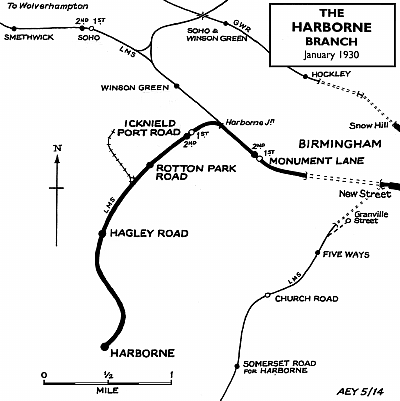 The first station at Icknield Port Road opened on the same day as the line and was located to the north-west of the road from which it took its name; a ramp provided access to the platform. Originally there was a single platform and building with a small awning on the right hand side of the line, with a platform-mounted signal box at the Harborne end. The initial service was six trains in each direction on Monday-to-Saturday with three in each direction on Sunday; two of the weekday trains operated as Parliamentary services, although all other services conveyed first, second and third class passengers. The Sunday service was short-lived owing to the residents of Hagley Road complaining about the ‘disturbance of their Sabbath‘. The first station at Icknield Port Road opened on the same day as the line and was located to the north-west of the road from which it took its name; a ramp provided access to the platform. Originally there was a single platform and building with a small awning on the right hand side of the line, with a platform-mounted signal box at the Harborne end. The initial service was six trains in each direction on Monday-to-Saturday with three in each direction on Sunday; two of the weekday trains operated as Parliamentary services, although all other services conveyed first, second and third class passengers. The Sunday service was short-lived owing to the residents of Hagley Road complaining about the ‘disturbance of their Sabbath‘.
During the first few years of operation the line was a financial success but this was not to continue. In 1879 the company went into Chancery owing to being petitioned by the rent charge holders with a Receiver being appointed by the Court of Chancery on 26 July of that year. It was not until 31 December 1900 that the company was released from Chancery having paid off all its debts. In the meantime the LNWR had made several abortive attempts to purchase the line outright but was continually rebuffed by the owners. Dividends paid by the company were never high, although during the period 1919 to 1922 a dividend of 3 per cent was paid.
From its initial six trains per day the passenger service had improved by 1895 when Bradshaw shows 19 down workings from Birmingham to Harborne on Monday-to-Friday with 18 on Saturday. There were 20 up services on Monday-to-Friday with 19 on Saturday. To placate the Hagley Road residents there was still no Sunday service.
| Up trains December 1895 |
Destination |
Down trains December 1895 |
Destination |
| 6.51am |
Birmingham New Street |
7.22am |
Harborne |
| 7.57am |
Birmingham New Street |
8.02am |
Harborne |
| 8.32am |
Birmingham New Street |
9.27am |
Harborne |
| 9.02am |
Birmingham New Street |
10.22am |
Harborne |
| 9.17am |
Birmingham New Street |
12.22pm |
Harborne |
| 9.50am |
Birmingham New Street |
1.02pm |
Harborne |
| 10.47am |
Birmingham New Street |
1.22pm SX |
Harborne |
| 12.47pm |
Birmingham New Street |
1.23pm SO |
Harborne |
| 1.52pm |
Birmingham New Street |
2.22pm |
Harborne |
| 2.17 SX |
Birmingham New Street |
3.22pm |
Harborne |
| 2.57pm |
Birmingham New Street |
4.27pm |
Harborne |
| 3.52pm |
Birmingham New Street |
5.22pm |
Harborne |
| 4.52pm |
Birmingham New Street |
6.07pm SX |
Harborne |
| 5.47pm |
Birmingham New Street |
6.32pm |
Harborne |
| 6.57pm |
Birmingham New Street |
7.22pm |
Harborne |
| 7.57pm |
Birmingham New Street |
8.22pm |
Harborne |
| 8.52pm |
Birmingham New Street |
9.22pm |
Harborne |
| 9.57pm |
Birmingham New Street |
10.07pm |
Harborne |
| 10.29pm |
Birmingham New Street |
10.53pm |
Harborne |
| 11.14pm |
Birmingham New Street |
11.37pm |
Harborne |
With the increase in traffic the branch trains began to get longer and the short platform at Icknield Port Road was unable to accommodate them. Thus, in 1897 a new station was opened on the opposite side of Icknield Port Road with a longer platform which allowed the lengthier trains to be fully accommodated. The original station was then closed and demolished.
Today there is no evidence that a station ever existed here as the cutting in which the line ran has been completely infilled. The overbridge on Icknield Port Road still exists, but only the bridge parapets are visible with the area around it incorporated within a public footpath.
Sources:
See also:
Monument Lane (1st), Monument Lane (2nd), Icknield Port Road (2nd), Rotton Park Road & Harborne
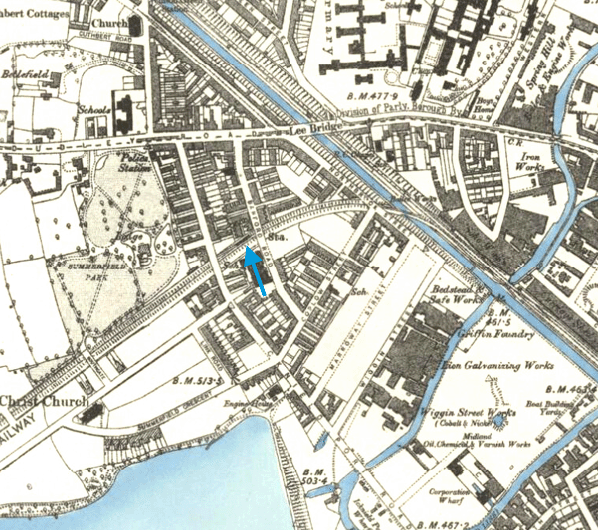
|

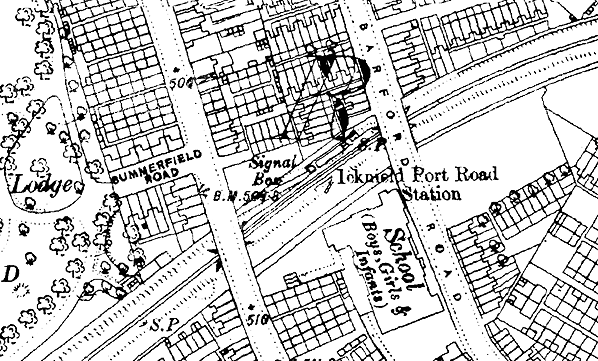
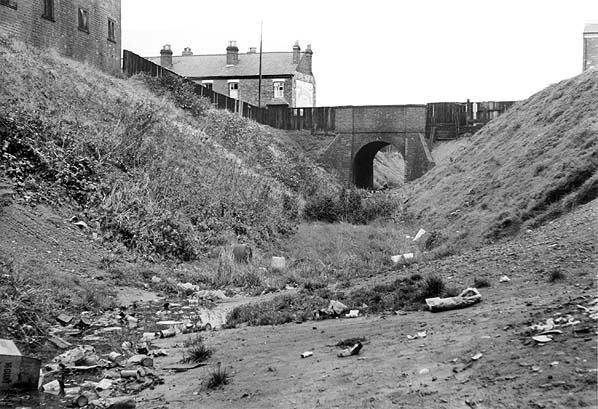
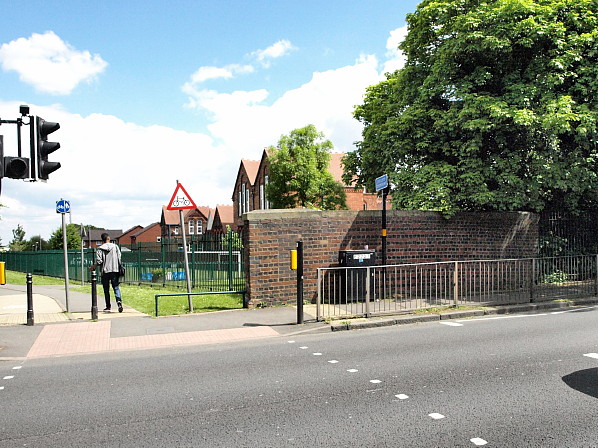
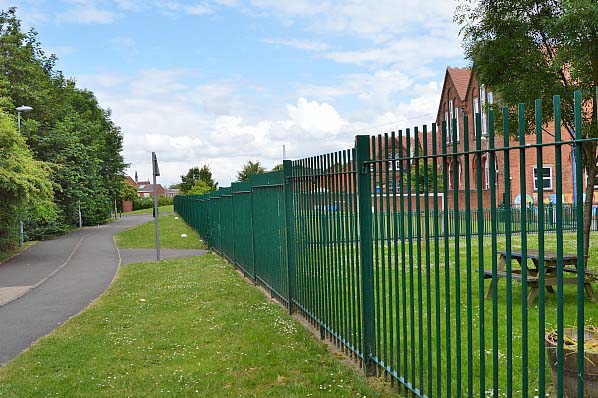
 The first station at Icknield Port Road opened on the same day as the line and was located to the north-west of the road from which it took its name; a ramp provided access to the platform. Originally there was a single platform and building with a small awning on the right hand side of the line, with a platform-mounted signal box at the Harborne end. The initial service was six trains in each direction on Monday-to-Saturday with three in each direction on Sunday; two of the weekday trains operated as Parliamentary services, although all other services conveyed first, second and third class passengers. The Sunday service was short-lived owing to the residents of Hagley Road complaining about the ‘disturbance of their Sabbath‘.
The first station at Icknield Port Road opened on the same day as the line and was located to the north-west of the road from which it took its name; a ramp provided access to the platform. Originally there was a single platform and building with a small awning on the right hand side of the line, with a platform-mounted signal box at the Harborne end. The initial service was six trains in each direction on Monday-to-Saturday with three in each direction on Sunday; two of the weekday trains operated as Parliamentary services, although all other services conveyed first, second and third class passengers. The Sunday service was short-lived owing to the residents of Hagley Road complaining about the ‘disturbance of their Sabbath‘. 

 Home Page
Home Page